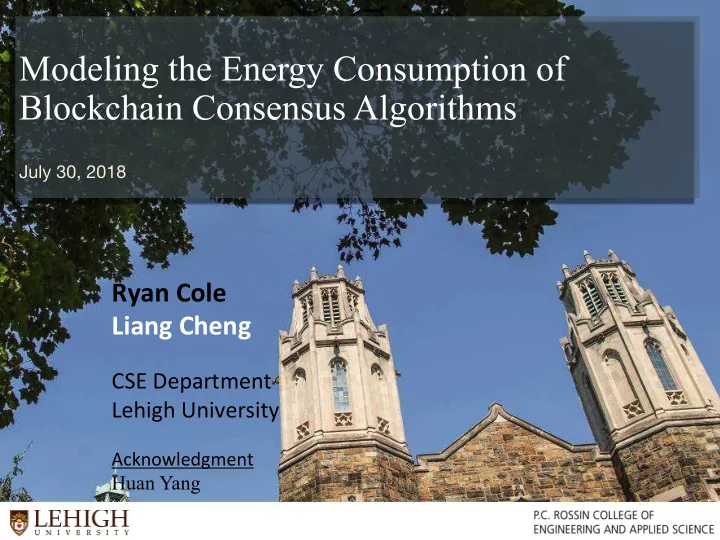

Candidates’ Day 2016 Modeling the Energy Consumption of Blockchain Consensus Algorithms Daniel Lopresti, Interim Dean P.C. Rossin College of Engineering and Applied Science April 15, 2016 July 30, 2018 Ryan Cole Liang Cheng CSE Department Lehigh University Acknowledgment Huan Yang Liang Cheng, Ph.D. IoT Blockchain Workshop http://liangcheng.info July 2018 ● Slide 1
Background Blockchain for Internet of Things Applications • Smart cities / communities • Smart transportation systems Advantages • Distributed trust via data immutability • Resilient system by distributed data storage Liang Cheng, Ph.D. IoT Blockchain Workshop http://liangcheng.info July 2018 ● Slide 2
Research Problem Energy Consumption Issues of using Blockchain for IoT Applications • Hundreds or even thousands of non-leaf nodes and/or ad hoc nodes Criticisms of blockchain tech- nologies, particularly Proof-of- Work-based systems • Digiconomist estimates that a single Bitcoin transaction uses over 800 kilowatt hour Liang Cheng, Ph.D. IoT Blockchain Workshop http://liangcheng.info July 2018 ● Slide 3
Our Approach Collecting real-world data and modeling the energy consumption of both PoW and non-proof-of-work coins and associated consensus algorithms • The size of the network • The number of messages sent per transaction • The computing cost of such a consensus protocol Liang Cheng, Ph.D. IoT Blockchain Workshop http://liangcheng.info July 2018 ● Slide 4
Consensus Algorithms Proof of Work • The original blockchain consensus algorithm Ripple Protocol Consensus Algorithm • A customized solution to the Byzantine Generals Problem Stellar Consensus Protocol • Federated Byzantine Agreement (FBA) using open membership and quorum slices Liang Cheng, Ph.D. IoT Blockchain Workshop http://liangcheng.info July 2018 ● Slide 5
PoW Proof of Work • Full nodes must solve a complex mathematical puzzle in order to be able to verify a group of transactions included in a block • In order to mine a block, a full- node miner must guess a nonce for the block • Once a block is mined the miner node will broadcast the block to the network for its validation by the rest of the network Liang Cheng, Ph.D. IoT Blockchain Workshop http://liangcheng.info July 2018 ● Slide 6
RPCA Ripple Protocol Consensus Algorithm • Ripple divides voting into rounds • Initially, each node collects all transactions that it has seen that have not yet been applied and then publishes them in what is known as a ”candidate set”. • Each node collects the candidate sets and votes on the validity of the transactions. • All transactions that receive more than a certain percentage of ”yes” votes proceed to the next round, if applicable. • In the final round, at least 80% of the nodes must vote yes on each transaction for it to be verified. • After this round, all transactions that have reached this threshold are added to the public ledger. Liang Cheng, Ph.D. IoT Blockchain Workshop http://liangcheng.info July 2018 ● Slide 7
SCP Stellar Consensus Protocol • A quorum is a set of nodes sufficient to reach an agreement. • Stellar also utilizes quorum slices, which is a subset of a quorum that can convince another node of agreement. • Each node decides upon a group of nodes that it trusts, which forms the node’s quorum slice. • There are two conditions for a node to accept a transaction • the node must have never accepted a conflicting transaction; • a large enough portion of the node’s quorum slice must also vote for or claim to accept the transaction. Liang Cheng, Ph.D. IoT Blockchain Workshop http://liangcheng.info July 2018 ● Slide 8
Data Collection Online Data Scraping • Proof-of-work coins from cryptocurrency statistics available online, including Bitcoin, Ethereum, Litecoin, Monero, and Vertcoin. • For each coin, we collected daily data on the number of transactions, the difficulty, hashrate, mining profitability, and price. • Using Digiconomist formula to estimate each coin’s daily energy usage Testbed • RPCA &SCP; energy consumption measured by Yokogawa power meter Liang Cheng, Ph.D. IoT Blockchain Workshop http://liangcheng.info July 2018 ● Slide 9
Modelling Results (1) PoW • LASSO (Least Absolute Shrinkage and Selection Operator) regression model • Estimates the energy usage of a cryptocurrency in kilowatt hours with 92% accuracy Liang Cheng, Ph.D. IoT Blockchain Workshop http://liangcheng.info July 2018 ● Slide 10
Modelling Results (2) Ripple Protocol Consensus Algorithm Stellar Consensus Protocol Liang Cheng, Ph.D. IoT Blockchain Workshop http://liangcheng.info July 2018 ● Slide 11
Conclusion and Future Work Linear regression models provide reference estimations of the energy consumption impact in designing blockchains for IoT systems Future research • Impact of sharding blockchain networks on energy consumption • Trade-offs between the energy usage and the transaction time on large-scale blockchains Nonlinear models Liang Cheng, Ph.D. IoT Blockchain Workshop http://liangcheng.info July 2018 ● Slide 12
Recommend
More recommend